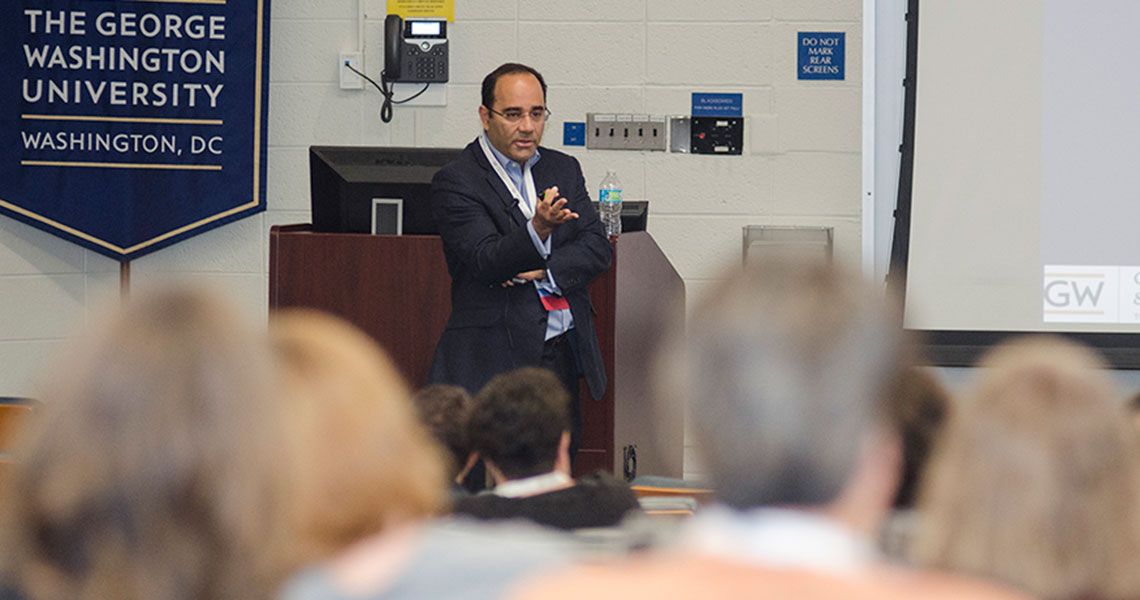Babak Sarani, MD ’97, RESD ’04, proselytized about the 30-year transformation of the GW Hospital Trauma and Critical Care Center to a crowd of George Washington University (GW) alumni in his talk during the 6th Annual Frank N. Miller Lecture, part of the 2017 GW School of Medicine and Health Sciences (SMHS) Reunion Weekend.
Sarani, director of Trauma and Acute Care Surgery at GW Hospital and associate professor of surgery at SMHS, said to laughter that accepting the offer in 2011 to return to his alma mater was “the single greatest thing I’ve done, short of marrying my wife.”
The man for whom the lecture series is named — Frank N. Miller, MD ’48, BS ’43, was a professor emeritus of pathology, a dean of students and curricular affairs, and a chair of the Department of Pathology at SMHS from 1944 to 1985 — would have related.
“[Miller] was a really beloved mentor, professor, colleague, and friend to many of us and many alumni throughout the history of this school,” Jeffrey S. Akman, MD ’81, RESD ’85, vice president for health affairs, Walter A. Bloedorn Professor of Administrative Medicine, and dean of SMHS, said at the start of the lecture. “When I talk to alumni, he comes up more frequently than any other former member of the faculty. Everybody has a Frank Miller story.”
After Akman’s introduction, Sarani led the audience through the trauma center’s phases of evolution, from 1981 when then-President Ronald Reagan was transported to the hospital after being shot to today’s efforts to install a helipad on the hospital’s roof.
“Back in 1981, there really were no trauma systems,” he recalled. “You were a trauma center if you basically said you were a trauma center. There were no guidelines or verification regulations.”
After a period of modest development around the turn of the century, the GW Hospital trauma center, with the help of leaders including Akman and former GW President Steven Knapp, found stronger footing in the D.C. region, Sarani said.
But first, GW had to decide why a Level 1 trauma center was so important, he added. “The university said, ‘our mission is to educate, and if the trauma center disappears, what happens to orthopedics? What about neurosurgery? What about emergency medicine? We have a huge stake in this trauma center.’
“The hospital said, ‘we have made a conscious decision that we will become a premier … referral center in the nation’s capital,’ ” he continued. “And the [GW Medical Faculty Associates] said, ‘we have all these contracts that are predicated on Level 1 status, including with the federal government.’ Everyone had skin in the game.”
So, where did they go from there?
“You start with quality, you don’t start with money; don’t worry about money,” Sarani said. “Money follows quality.”
One step Sarani took along the path toward quality was setting up a multidisciplinary committee to identify and discuss morbidities and mortalities in the trauma center in a very blunt way, an effort to ensure such events don’t happen again. The committee, which meets monthly, includes attending physicians in orthopedics, neurosurgery, radiology, general surgery, and anesthesiology, among other specialties. “Doctors don’t run hospitals, teams run hospitals,” Sarani said.
By bringing people together, he added, the hospital’s quality measures started going up, which led to residents choosing GW to pursue trauma surgery training. Those first steps led to a natural culture change that occurred over about three years, he noted.
Another step Sarani took was to increase the number of patients transferred for non-trauma related reasons. “Our culture is ‘We can do this. We don’t say no,’ ” he said. “We’re not busy at all times. We have capacity in the system, so why don’t we reach out to our community partners and say ‘send us your business, send us your patients who need help?’ ”
Opening those doors greatly increased the number of patients treated for non-trauma emergencies such as stroke and sepsis, rising from 422 patients in 2013 to more than 2,000 being treated in 2016, Sarani said.
The biggest issue now is getting the region’s sickest patients to the hospital as safely and swiftly as possible, he added. To help solve that problem, Sarani is leading an effort to have a helipad installed on its roof of GW Hospital.
Before the project can move forward, however, a 30-year-old law that restricts helipads in residential areas of the city must be overturned. It’s an uphill battle, but one that GW hospital and Sarani are tackling head on, with sights set on the skies and saving lives.



